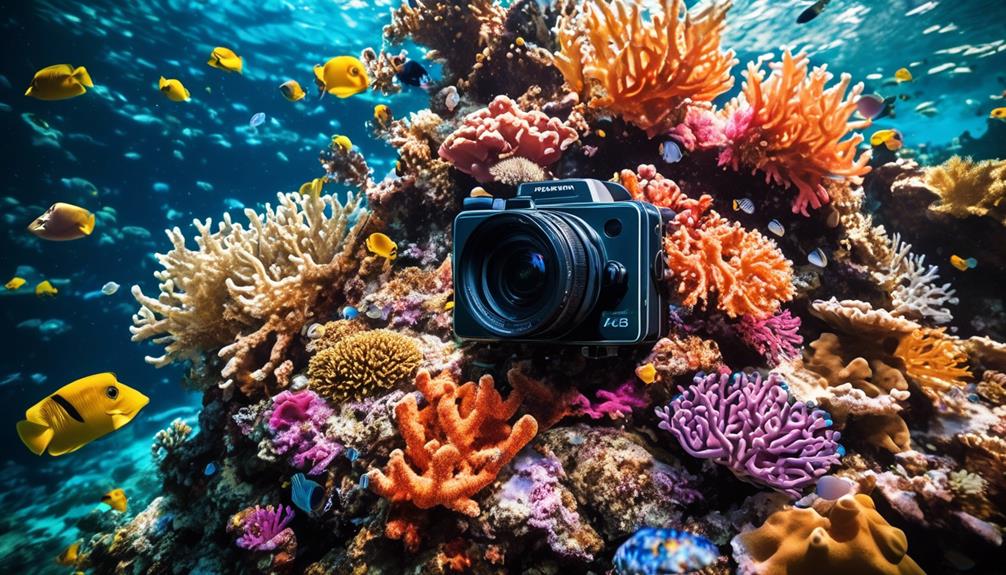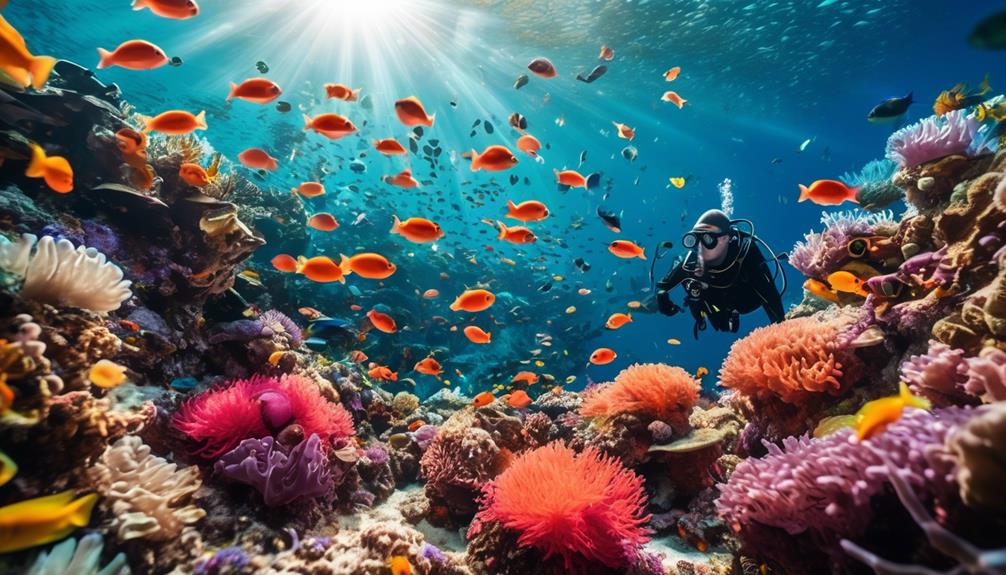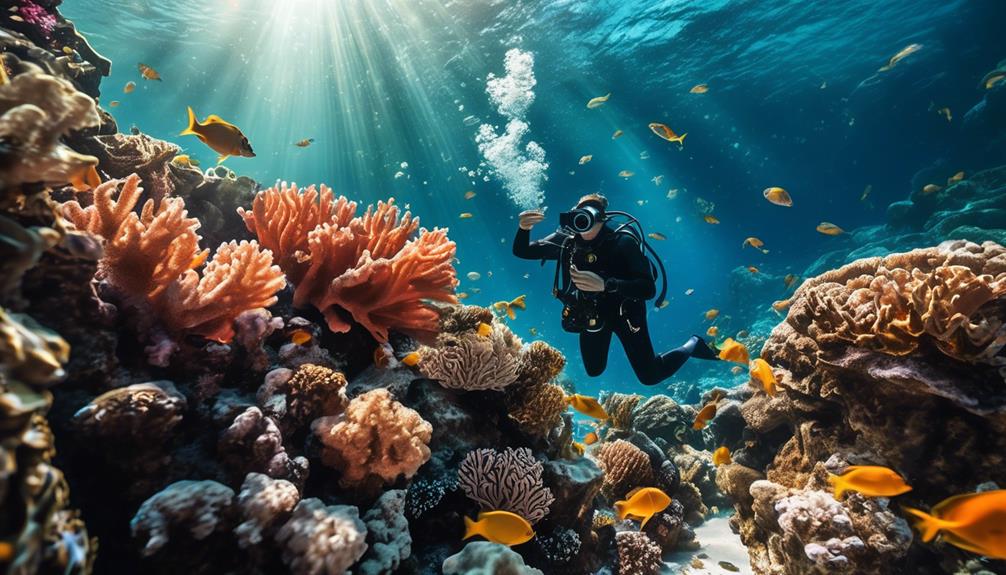Please note this post may contain affiliate links picked by me (Jay) that I have deemed may be of interest or relevant to you the reader of this.
These links do not affect the cost of the thing if you decide to purchase but i may get a little money if you choose to purchase.
For more information on my affiliate link policy click here.
As I descended into the depths of the ocean, my camera clutched tightly in my hands, I couldn't help but feel like a lone explorer in a vast, mysterious world.
The vibrant colors of the coral reefs danced before my eyes, and the graceful movements of the marine life captivated my every sense.
Little did I know that this dive into underwater marine photography would unlock a whole new realm of creativity and adventure. With each click of the shutter, I discovered the secrets of capturing the beauty that lies beneath the waves.
And now, I'm about to share with you the tips and tricks that will elevate your underwater photography to new depths.
So, are you ready to dive in and discover the wonders that await?
Key Takeaways
- Choosing a reliable camera that can withstand harsh conditions is crucial for underwater photography.
- Regular maintenance, such as rinsing the camera with fresh water and checking O-ring seals, is important to prevent leaks.
- Investing in the best lenses, such as wide-angle, macro, and fisheye lenses, is essential for capturing different underwater shots.
- Proper lighting, including the use of strobes, video lights, diffusers, and snoots, is crucial for overcoming the challenges of shooting in low light conditions underwater.
Choosing the Right Underwater Camera
When it comes to capturing the wonders of the underwater world, choosing the right underwater camera is absolutely essential. As an adventurous underwater photographer, I understand the importance of having a reliable camera that can withstand the harsh conditions of the deep blue sea. Not only do you need a camera that can capture stunning images, but also one that's easy to maintain and has adjustable settings to suit your needs.
Underwater camera maintenance is crucial to ensure that your camera stays in top shape and ready for your next dive. After each use, it's important to rinse your camera with fresh water to remove any salt or debris that may have accumulated. Regularly checking and cleaning the O-ring seals is also essential to prevent any leaks. Investing in a good camera housing will provide additional protection and make maintenance easier.
Another key aspect to consider when choosing an underwater camera is the settings it offers. Look for a camera that allows you to adjust the white balance, exposure, and focus settings. These features will enable you to capture vibrant and well-balanced images, even in challenging lighting conditions. Additionally, having the ability to shoot in RAW format will give you more flexibility during post-processing.
Essential Gear for Underwater Photography
As an avid underwater photographer, I can't emphasize enough the importance of having the right gear for capturing the mesmerizing beauty that lies beneath the ocean's surface. When it comes to underwater photography, two essential pieces of gear that you must invest in are underwater housing options and the best lenses for underwater photography. Let's dive right in and explore these gear options in more detail.
Underwater Housing Options
Underwater housing is like a protective case for your camera, allowing you to take it underwater without damaging it. There are various options available, ranging from affordable compact camera housings to high-end professional housings. The choice depends on your budget and the level of underwater photography you plan to pursue. Here are three popular underwater housing options:
| Housing Option | Features | Price Range |
|---|---|---|
| Compact | Lightweight and affordable | $100-$500 |
| Mirrorless | Interchangeable lenses, advanced controls | $500-$2000 |
| DSLR | Professional-grade, customizable | $2000-$5000+ |
Best Lenses for Underwater Photography
Choosing the right lens is crucial for capturing sharp and vibrant underwater images. Here are three lenses that are highly recommended for underwater photography:
| Lens | Description | Price Range |
|---|---|---|
| Wide-Angle | Ideal for capturing expansive underwater landscapes | $500-$2000 |
| Macro | Perfect for close-up shots of small marine creatures | $400-$1500 |
| Fisheye | Creates a unique and distorted perspective underwater | $600-$2500 |
Investing in underwater housing options and the best lenses for underwater photography will greatly enhance your ability to capture the stunning beauty of the underwater world. Remember to choose gear that suits your budget and photography goals. Happy diving and snapping!
Understanding Underwater Lighting Techniques
Now that we've covered the essential gear for capturing breathtaking underwater photographs, let's dive into the captivating world of underwater lighting techniques.
When it comes to underwater photography, lighting is a crucial element that can make or break your shot. Whether you're shooting vibrant coral reefs or tiny marine creatures in macro photography, understanding how to manipulate light underwater is essential.
One of the biggest challenges underwater photographers face is shooting in low light conditions. As you descend deeper into the water, the sunlight becomes less intense, resulting in dimmer and bluer images. To combat this, you can use artificial lighting sources such as strobes or video lights.
Strobes are powerful flashes that can help illuminate your subject and bring out its colors in the dark depths. Video lights, on the other hand, provide a continuous source of light, which is useful for shooting videos or capturing fast-moving subjects.
Another technique to consider is using light diffusers or snoots. Diffusers help soften the harsh light emitted by your strobes, creating a more natural and pleasing effect. Snoots, on the other hand, allow you to focus the light on a specific area, perfect for highlighting intricate details in macro photography.
Understanding underwater lighting techniques won't only enhance the quality of your photographs but also allow you to unleash your creativity and capture mesmerizing images.
Composition Tips for Capturing Marine Life
To capture stunning photographs of marine life, it's essential to master the art of composition. Underwater photography presents unique challenges, but with the right techniques, you can create visually captivating images that showcase the beauty of the underwater world. Here are some composition tips to help you capture the essence of marine life:
| Composition Tip | Description | Example Image |
|---|---|---|
| Rule of Thirds | Divide your frame into a 3×3 grid and place key subjects at the intersections or along the lines. |  |
| Leading Lines | Use lines to guide the viewer's eye towards the main subject, creating a sense of depth and movement. |  |
| Negative Space | Embrace empty spaces to highlight the subject and create a sense of tranquility. |  |
| Color Contrast | Utilize contrasting colors to make your subject stand out and add visual impact to your images. |  |
| Depth of Field | Experiment with shallow and wide depths of field to add dimension and focus to your images. |  |
Editing Tips for Stunning Underwater Photos
When it comes to editing stunning underwater photos, there are a few key tips that can take your images from good to breathtaking.
One of the first things you'll need is underwater photo editing software. There are several options available, each with its own set of features and capabilities. Look for software that allows you to easily adjust colors, enhance details, and remove any unwanted elements from your photos.
Once you have the right software, it's time to dive into the editing process. One of the most important techniques to master is color correction. Underwater photos often suffer from a loss of color due to the water's filtering properties. To bring back the vibrant hues, play around with the white balance and saturation levels. You can also use selective color adjustments to make certain elements pop.
Another useful editing technique is to enhance the details in your photos. Underwater images can sometimes appear soft or lacking in sharpness. Use tools like sharpening, clarity, and contrast to bring out the fine details and make your subjects stand out.
Don't be afraid to experiment and get creative with your edits. Underwater photography offers a unique canvas for innovation. Play with different filters, overlays, and effects to give your photos a distinct look and feel.
Frequently Asked Questions
How Do I Maintain the Waterproof Seals on My Underwater Camera?
Maintaining waterproof seals on your underwater camera is crucial for protecting your equipment. Common mistakes include not properly cleaning the seals after each dive and not checking for any signs of wear and tear.
To troubleshoot, always double-check that the seals are clean and free of debris before diving. Regularly inspect them for any cracks or damage, and replace them if necessary.
What Are the Best Settings to Use for Underwater Photography?
When it comes to underwater photography, finding the best settings is key.
You'll want to experiment with different underwater lighting techniques to capture the vibrant colors beneath the surface.
And let's not forget about the lenses! Choosing the right lens can make all the difference in capturing those stunning underwater shots.
How Can I Prevent Backscatter in My Underwater Photos?
To prevent backscatter in my underwater photos, I've discovered a nifty trick that works wonders. It's all about minimizing reflections and dealing with those pesky low light conditions.
By using a lens hood or shade, I can block out any unwanted light that may bounce off particles in the water.
Additionally, adjusting my camera's settings to reduce the ISO and increase the shutter speed helps capture clearer shots.
With these techniques, my underwater photography game has reached new depths!
Are There Any Specific Safety Precautions I Should Take During Underwater Photography?
When it comes to underwater photography, safety is key. Before diving into the deep blue, make sure you have the right underwater photography equipment, like a sturdy housing for your camera.
Don't forget to brush up on your underwater photography techniques too, like adjusting your settings for the best lighting and composition.
And of course, always prioritize safety by diving with a buddy and following proper diving protocols.
What Are Some Common Challenges Faced in Underwater Photography and How Can I Overcome Them?
Overcoming challenges in underwater photography can be quite an adventure! One common challenge is mastering lighting techniques underwater. It's like playing with shadows in an underwater wonderland.
But fear not, my fellow explorers, for with a little ingenuity and some handy equipment, we can conquer this obstacle. By using strobes or underwater flash, we can illuminate our subjects and bring out their vibrant colors.
Conclusion
So there you have it, my fellow underwater explorers! I hope this dive into the world of underwater marine photography has left you feeling inspired and ready to capture the beauty that lies beneath the waves.
Remember, with the right camera, gear, lighting techniques, and composition skills, you can create stunning underwater photos that will wow your friends and family.
And here's a fun fact to leave you with: Did you know that the Great Barrier Reef is home to over 1,500 species of fish?
So get out there, dive in, and start snapping away! Happy shooting!


